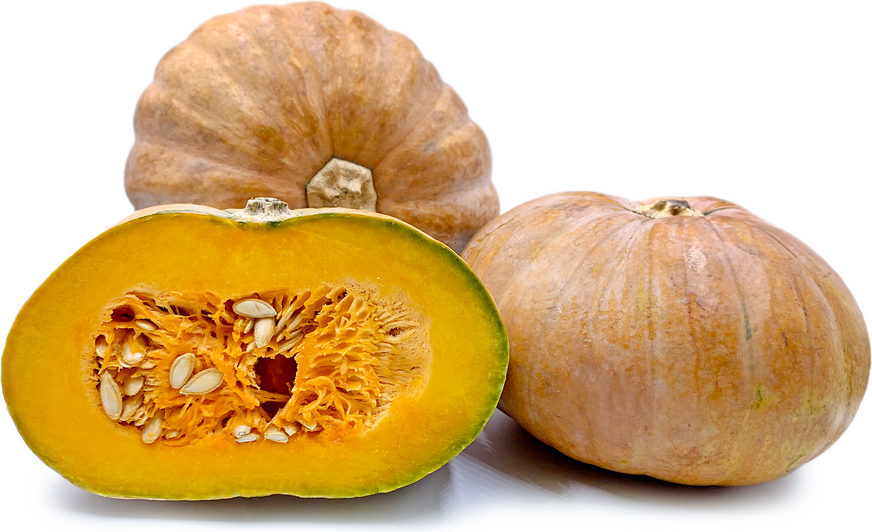


Calabaza Squash
Estimated Inventory, 25 lbs : 0
Description/Taste
Calabaza squash ranges in size from small like a cantaloupe to large like a watermelon and has a round to pear-like shape. Its exterior skin is hardened, often lined with large vertical ridges and when mature, its rind can be mottled green to yellow-orange and is often striped or splotched with varying shades of green. Calabaza squashes can also be one solid color or multi-colored depending on open pollination. The firm, yellow to orange flesh surrounds a large, central seed cavity with stringy pulp and many small, flat, and hard cream-colored seeds. Calabaza squash, when cooked, is smooth, fine-textured, and has a mild, sweet, and nutty flavor similar to butternut or acorn squash.
Seasons/Availability
Calabaza squash is available year-round, with peak season in the fall through winter.
Current Facts
Calabaza squash, botanically classified as Cucurbita moschata, is a tropical variety known for its long creeping vines and is a member of the Cucurbitaceae family along with pumpkins and gourds. The word calabaza often signifies several species of hard squash in the Americas with dramatic variances in shape, size, and texture due to natural outcrossing from open pollination. Also known as West Indian pumpkin, Cuban squash, Zapollo, Auyama, Abóbora, Calabash, Calabasa, and Green pumpkin, Calabaza squash is an important crop in developing countries today and is grown predominately in tropical and subtropical regions throughout Latin America. Calabaza squash is known for its creamy texture and mild flavor and is commonly sold pre-cut into large chunks in fresh markets and wrapped in plastic for ease of use.
Nutritional Value
Calabaza squash contains vitamins A and C, some B vitamins, thiamine, riboflavin, fiber, and beta-carotene.
Applications
Calabaza squash is best suited for cooked applications such as baking, steaming, roasting, grilling, braising, or sautéing and can be cut in half, seeded, and roasted as is or cut into wedges or cubes and prepared. Calabaza squash can be added to stir-fries, casseroles, curries, and stews and also makes an excellent stuffing for enchiladas, quesadillas, empanadas, and tacos. When cooked and pureed, its smooth texture is ideal for pies, puddings, bread, or soups, and it can also be used as a substitute in recipes where pumpkin or butternut squash is called for. Calabaza squash pairs well with shallots, raisins, pine nuts, maple syrup, cumin, cinnamon, roasted poultry, fish, brown sugar, orange zest, crème fresh, chili peppers, corn, lime juice, arugula, rice, and sausage. It will keep 1-2 months when stored unwashed in a cool and dark place. Cut pieces of squash will keep up to one week when wrapped in plastic and stored in the refrigerator.
Ethnic/Cultural Info
Calabaza is the generic Spanish term for squash and is extremely popular in Latin American cuisine. In Mexico, Calabaza is used to make Calabaza en tacha which is pumpkin candied in sugar, guava, and cinnamon syrup and is served as a traditional dessert on Dia de Los Muertos. In Puerto Rico, Calabaza with a deep yellow to orange flesh is preferred over lighter fleshed varieties and is added to stews such as sanchco, soups as a thickener, moles, tamales, and to rice and beans. Demand for Calabaza squash from Latin American populations around the world has increased, especially in Florida and other parts of the United States in the past thirty years. The Calabaza is luckily well suited to the climate of Florida and can be grown there year-round. Plant breeders in Florida have been working to breed new varieties of Calabaza that offer a shorter growing cycle and a higher yield of fruit on compact vines.
Geography/History
Calabaza squash is native to the Americas and is its origins are believed to date back over 7,500 years ago. Calabaza squash was then introduced to Spanish explorers and was spread across the world on via continued exploration voyages. Today Calabaza squash can be found at local markets and specialty grocers and is grown throughout the Caribbean, Central America, South America, Europe, as well as parts of Africa and North America.

Recipe Ideas
Recipes that include Calabaza Squash. One
| 2 Sisters Recipes |
|
Pasta with Calabaza Squash |
| Mexico Cooks! |
|
Calabaza en Tacha |
| Latest Recipes |
|
Calabasa Squash in Coconut Milk |
| Vegan In The Sun |
|
Breadfruit Raviolo with Calabaza Squash Filling |



